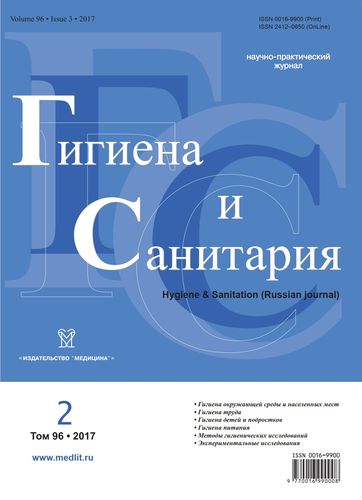Hygiene and the spectral energtic light pattern
- 作者: Kaptsov V.A.1, Deynego V.N.2, Soshmn N.P.3, Ulasyuk V.N.3
-
隶属关系:
- All-Russian Research Institute of Railway Hygiene of the Federal Service for the Oversight of Consumer Protection and Welfare
- Ltd "New energy technologies"
- ZAO Company "ELTAN"
- 期: 卷 96, 编号 2 (2017)
- 页面: 101-106
- 栏目: ENVIRONMENTAL HYGIENE
- ##submission.datePublished##: 21.10.2020
- URL: https://edgccjournal.org/0016-9900/article/view/640588
- DOI: https://doi.org/10.47470/0016-9900-2017-96-2-101-106
- ID: 640588
如何引用文章
全文:
详细
There are considered methodological bases of multicriteria synthesis of a spectral energetic pattern for the evaluation of the excessive share of blue and red light in the spectrum of artificial energy sources. The basis of this methodology is relied upon on the hygienic approach to the spectrum analysis of solar and led light. Relying upon on "photobiological paradox of vision" according to M. A. Ostrovsky, conditions of "melanopsin cross" and mechanisms of adverse impact of light on vision, all the spectral-energy characteristics of solar light were divided into subspaces. The border between them became a spectral energy pattern for the evaluation of artificial sources on the security of their impact on eye and human health according to criteria of the excessive dose of blue or red light. On two examples there was shown the effectiveness and clarity of this estimation with the using of the spectral energetic pattern of light.
作者简介
Valery Kaptsov
All-Russian Research Institute of Railway Hygiene of the Federal Service for the Oversight of Consumer Protection and Welfare
编辑信件的主要联系方式.
Email: kapcovva39@mail.ru
俄罗斯联邦
V. Deynego
Ltd "New energy technologies"
Email: noemail@neicon.ru
俄罗斯联邦
N. Soshmn
ZAO Company "ELTAN"
Email: noemail@neicon.ru
俄罗斯联邦
V. Ulasyuk
ZAO Company "ELTAN"
Email: noemail@neicon.ru
俄罗斯联邦
参考
- Вавилов С.И. Глаз и Солнце. М.: Наука; 1976.
- Holm S. Does chaos theory have major implications for philosophy of medicine? Med. Humanit. 2002; 28(2): 78-81.
- Еськов В.М., Еськов В.В., Джумагалиева Л.Б., Гудкова С.В. Медицина и теория хаоса в описании единичного и случайного. Вестник новых медицинских технологий. 2014; 21(3): 27-34.
- Scientific output (1975-2013): chaos theory vs. evidence based medicine. Available at: https://figshare.com/articles/Scientific_output_1975_2013_chaos_theory_vs_evidence_based_medicine/1216702
- РИА Новости. Математики научились обсчитывать хаос и последствия «эффекта бабочки». Available at: http://ria.ru/science/20150728/1151525068.html#ixzz3z5w4x3XJ
- Зуева М.В. Нелинейные фракталы: приложения в физиологии и офтальмологии. Офтальмология. 2014; 11(1): 4-11.
- Дейнего В.Н., Капцов В.А., Сорока А.И. Влияние света и физических полей на риск дисгармонизации синтеза мелатонина в шишковидной железе. Анализ риска здоровью. 2014; (2): 30-41.
- Капцов В.А., Дейнего В.Н. Избыточная доза синего света в спектре светодиодного освещения может ухудшить зрение. Энергосвет. Available at: http://www.energosovet.ru/stat875.html
- Островский М.А. Фотобиологический парадокс зрения. В кн.: Рубин А.Б., ред. Проблемы регуляции в биологических системах. Биофизические аспекты. М.: Институт компьютерных исследований; Ижевск: РХД; 2007: 133-64.
- Зак П.П., Островский М.А. Потенциальная опасность освещения светодиодами для глаз детей и подростков. Светотехника. 2012; (3): 4-6.
- Зак П.П., Сережникова Н.Б., Погодина Л.С., Трофимова Н.Н., Гурьева Т.С., Дадашева О.А. Фотоиндуцированные изменения субклеточных структур ретинального пигментного эпителия перепела Coturnix japonica. Биохимия. 2015; 80(6): 931-6.
- Сигаева А.О., Сережникова Н.Б., Погодина Л.С., Трофимова Н.Н., Дадашева О.А., Гурьева Т.С. и др. Изменения сосудистой оболочки глаза разновозрастных групп японского перепела Coturnix Japonica в зависимости от спектрального состава освещения. Сенсорные системы. 2015; 29(4): 354-61.
- Новиков Н.Ю. Отмена переходов на летнее и зимнее время в Российской Федерации. Available at: http://federalbook.ru/news/analitics/25.08.2011.html
- Tomany S.C., Cruickshanks K.J., Klein R., Klein B.E., Knudtson M.D. Sunlight and the 10-year incidence of age-related maculopathy: the Beaver Dam Eye Study. Arch. Ophthalmol. 2004; 122(5): 750-7.
- Дейнего В.Н., Капцов В.А. Свет энергосберегающих и светодиодных ламп и здоровье человека. Гигиена и санитария. 2013; 92(6): 81-4.
- Феоктистова Т.Г., Феоктистова О.Г., Наумова Т.В. Безопасность жизнедеятельности. Производственная санитария и гигиена труда. Часть II. М.; 2007.
- Wallman J., Winawer J. Homeostasis of eye growth and the question of myopia. Neuron. 2004; 43(4): 447-68.
- Iseli H.P., Körber N., Koch C., Karl A., Penk A., Huster D. The Effects of Scleral Blue Light Cross-linking on Eye Growth. 2010.
- Foulds W.S., Barathi V.A., Luu C.D. Progressive myopia or hyperopia can be induced in chicks and reversed by manipulation of the chromaticity of ambient light. Invest. Ophthalmol. Vis. Sci. 2013; 54(13): 8004-12.
- Albarracin R., Natoli R., Rutar M., Valter K., Provis J. 670 nm light mitigates oxygen-induced degeneration in C57BL/6J mouse retina. BMC Neurosci. 2013; 14: 125.
- Sunlight spectrum reproducible white LED (TRI-R). Available at: http://www.toshiba-tmat.co.jp/eng/case_tri_r/index.htm
- Chu Y.C., Lee G.J. Improved Design of UV- and Blue-Light-Inhibited White Light-Emitting Diode. IEEE Photonics J. 2015; 4(7): 1600806.
补充文件







